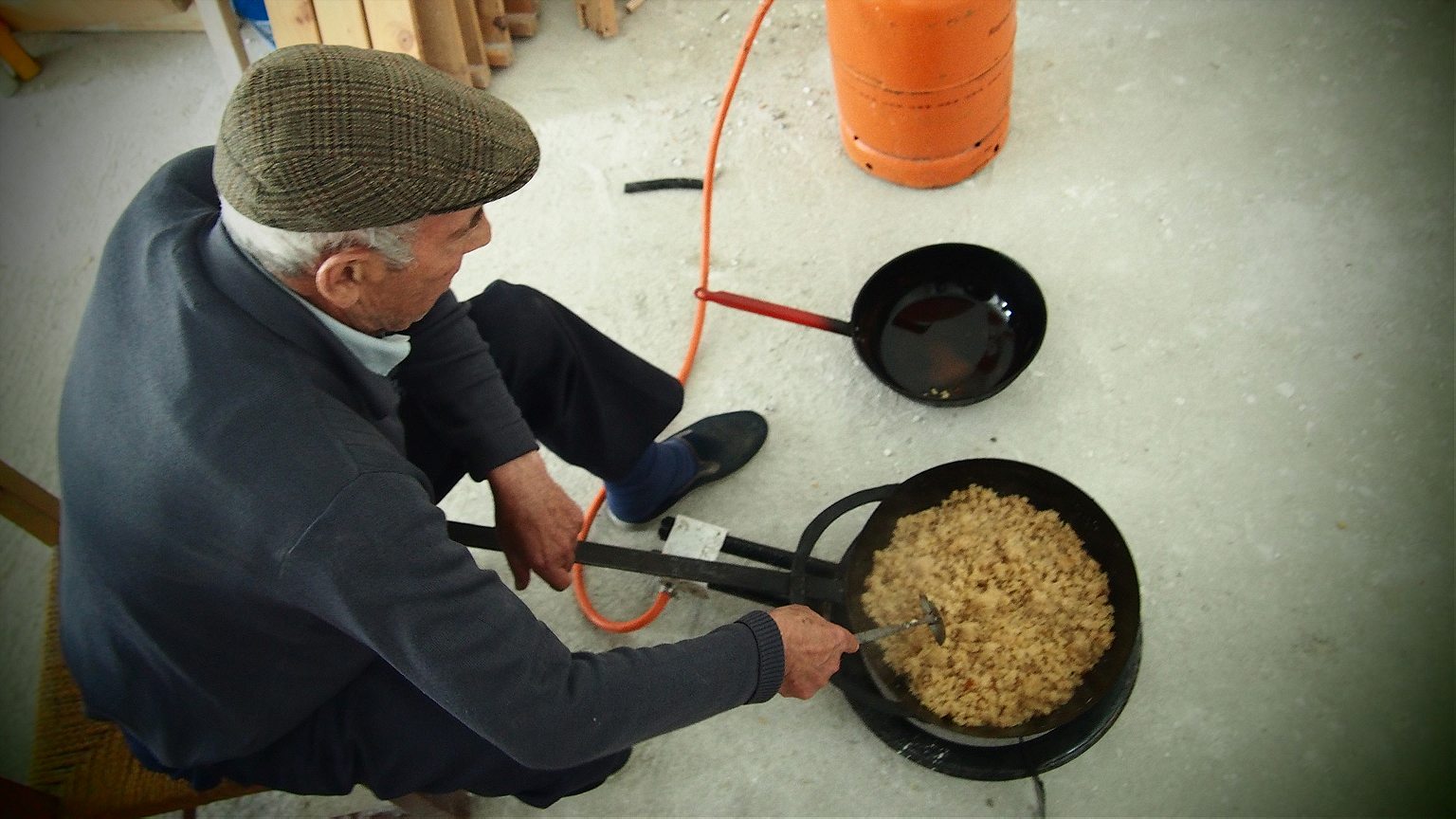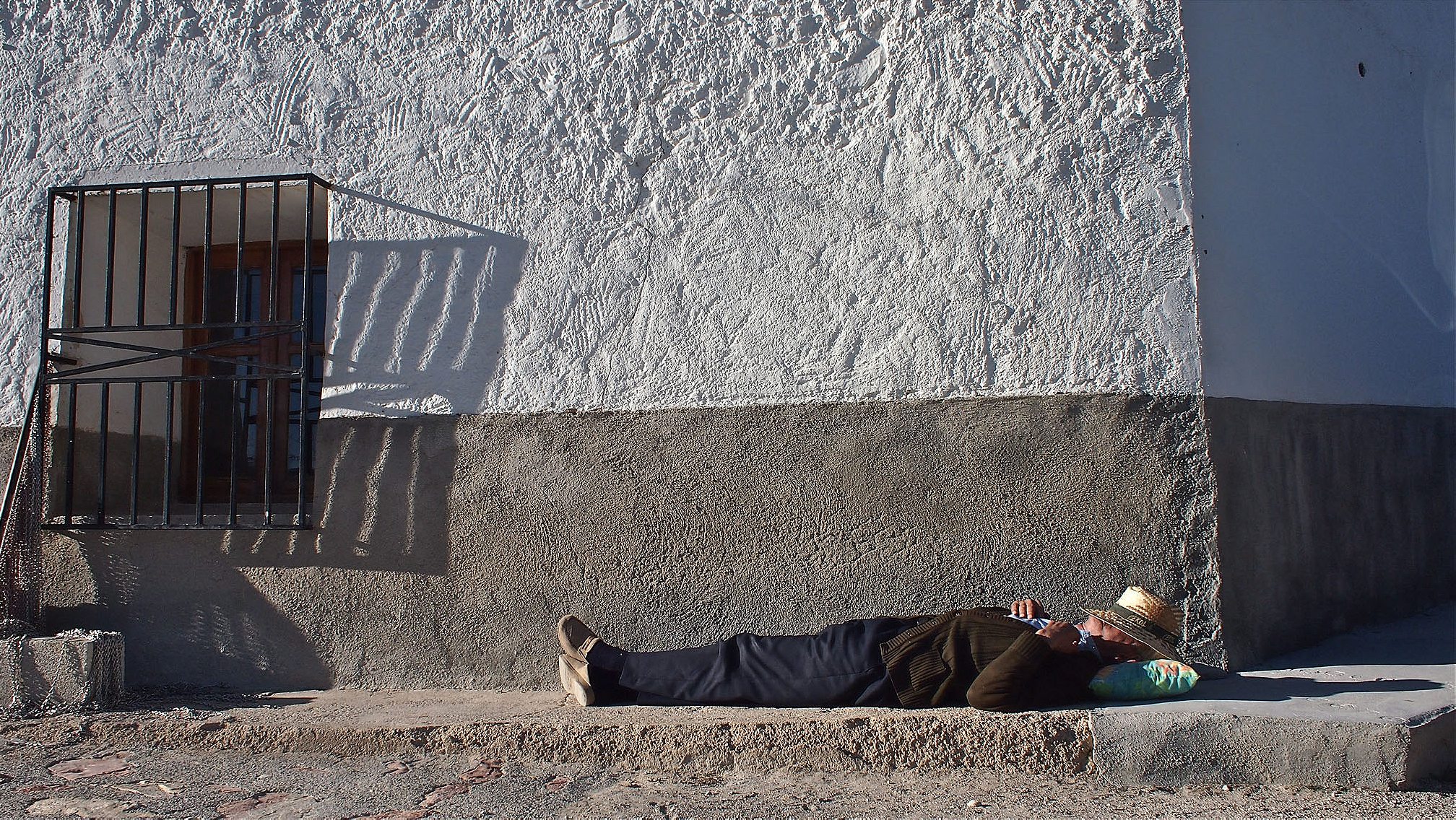Federo Motos is a farmer, a cave dweller and a master of migas, the humble creation of Spanish shepherds
Listen to an immersive interview about this story with author Matt Goulding on our podcast The Trip
Federico Motos Lajara was born October 3rd, 1930, six years before the Spanish Civil War, in a cave 140 kilometers east of Granada. He stands nearly 6 feet tall, with a wispy wheat stalk for a frame and smooth brown cheeks that belie a life spent under the Andalusian sun. He is a shepherd by trade, a bachelor by choice, and a cave dweller by both love and necessity. And in two months’ time, when I take Laura Pérez to be my lawful wedded wife, Chacho Federo will be my great uncle.
Laura is Catalan-Andaluz, born and raised near Barcelona, but with both sides of her family hailing from the south of Spain. Her father Angel was also born and raised in Fuente Nueva, a community that at its height in the 1950s and 60s had up to 500 people living as farmers, shepherds and craftsmen. Cave communities took root during Muslim rule in Andalusia, the northern Africans finding the Spanish terrain a perfect place to continue their long tradition of countryside cave dwelling. The habit stuck, and 500 years after the Moors were driven from Spain the caves remain, mainly because of a number of distinct physical advantages they provide: not only do they offer inexpensive, effective protection from the elements, they maintain an unexpectedly comfortable ambient temperature year round, taking the edge off the harsh winters and brutal summers that define this desert terrain.
My first trip to Fuente Nueva came in December of 2010, a far-reaching attempt to convince Laura and her family that I was serious about my commitment to this country. In three shorts days, I drank whisky with the local men, hung chorizo with the local women, and helped turn a pig into a year’s worth of charcuterie for strangers I wanted to desperately call my family. Since then, I’ve been fortunate enough to spend a few weeks out of each year with Laura’s people in the south, and gradually over this time, they’ve become my people, too. None more so than Chacho Federo.

With the exception of a military stint in Morocco, Chacho has spent his entire life in the caves of Fuente Nueva, working primarily as a goat herder and wheat farmer in the amber plains surrounding the caves. Back in those days, he would deliver his goods to local markets on the back of a horse or a donkey, clad in wool cardigans and flannel shirts and espadrilles before los hipsters were even a concept. Like everybody in Fuente Nueva, he doesn’t speak Spanish; he speaks Andaluz. On paper, they are the exact same language, but leaving the mouth of a native speaker, Andaluz sounds like another dialect entirely, one almost entirely free of consonants. It has taken three years of intense study and concentration, but I now proudly understand about 50 percent of what comes out of Chacho’s mouth.
I have learned a lot about life in the south from Chacho over the past few years. I have learned that the respectable hour to wake up is 5 am, before the sun has stirred, in order to turn those waning embers into a waxing fire to warm the morning. I have learned that in the lean post-war years in Fuente Nueva, suicide became an epidemic, and Chacho acted as a catcher in the rye of sorts, rescuing desperate women who had thrown themselves into community wells. I have learned that a man subsisting on a diet of chorizo, fried sardines and hand-rolled cigarettes can be healthier than any God-fearing, doctor-loving relative I have in the States.
But the first lesson I ever learned from Chacho, before the bar crawls and soil tilling and history lessons that would follow, was how to make migas. The word means crumbs in Spanish, and in most places throughout Spain, migas are about a second life, a way to turn abandoned bread into a meal soft and savory enough to sustain workers for the long afternoon ahead. It’s a campo creation, invented by the shepherds who would spend all day moving their goat and sheep from one swatch of land to the next. Migas across Spain abide by a general formula, but everywhere you turn you find local tweaks and adaptations. In La Mancha, migas come laced with garlic and peppered with pork fat; in Almeria, the base may start with coarse semolina instead of refined wheat, and the accompaniments will probably include a few varieties of small, oily fish.
In Fuente Nueva, migas have always been about four ingredients, the most elemental and abundant of all: flour, water, oil and salt. Chacho starts with a liter of water in a special migas pan, a heavy-bottomed iron vessel with an extra handle, the easier to control and transport the final product. When the water is hot, he adds flour, then salt, and later, little by little, warm ladles of olive oil.
Many times I’ve tried to take down a recipe, and many times I’ve been denied.
“How much oil, Chaco? How much salt?”
“Por ojo.” Eyeball it. There are no set ratios; Chacho’s migas are the product of 83 years of careful finesse.
Occasionally, after a glass or two of wine, he might offer up a few breadcrumbs of advice. “The most important thing is to work the dough as much as possible. You have to get the water out of it and cook the raw flour.” For that reason, migas demand a low, steady flame and constant stirring. And done Chacho’s way, they require just three tools: an iron spatula for cutting the dough, an iron spoon for turning it, and a wad of tobacco for smoking away the time it takes to turn raw flour into warm little dumplings.

In a world where women do 90 percent of the cooking and 100 percent of the cleaning, migas provide a rare chance for the hombres de Andalusia to earn their domestic keep. The men like to tell themsleves, as Chacho puts it, that migas take muscle—not just for the constant stirring required to break up larger chunks of dough into smaller and smaller pieces, but also to lift the entire pan into the air and flip the bulky mass of flour and water with the same push-pull action a chef might use to keep a pan of sautéed mushrooms in motion.
A veteran migas cook knows how to work the pan, how to coerce from that shapeless slurry of flour and water a golden mountain of perfect pebbles, blessed with an exalted balance of crisp exterior and moist interior. Done properly, a dollar worth of flour and oil can feed a family of 12 happily. The toppings that make the rounds —a mischievous mix of fried pork and salted sardines, orange slices and chocolate chunks—mean nothing if the migas don’t sing.
The eating ritual may be nearly as important as the methodic cooking. Once the women and children have their little piles placed before them, the men grab their spoons, gather around the pan and, not unlike the Valencianos to the north sitting down to a great circle of paella, begin to eat their way to the center. Little is said during these migas moments, most attention devoted instead to mixing the warm piles of dough with the right combination of salty, sweet, savory and spicy add-ons. Give me crispy nickels of spicy chorizo, a blanket of fried green pepper and a wedge of raw onion and you won’t hear a word from me until my spoon lands in the middle.
The only thing as inevitable as the cigarette and wine that precede migas is the afternoon siesta that follows it. On most days for Chacho, that means a little shuteye next to the fire in the living room. But on a warm afternoon, when the wind has died down and the entrance to the cave sparkles in the sunlight, Chacho might just stretch out under the big blue sky and sleep until dinnertime. War, drought, pestilence, Americans: he and his migas have survived it all.

You can listen to the full episode, for free, on Apple Podcasts, Stitcher, Spotify, or wherever you get your podcasts.